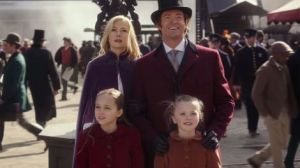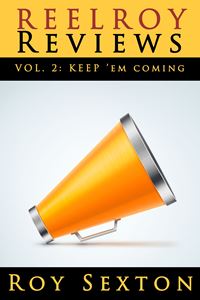![[Image Source: Wikipedia]](https://reelroyreviews.files.wordpress.com/2015/12/the-wiz-live.jpg?w=193&h=300)
[Image Source: Wikipedia]
I’ve always been an Oz-nut for as long as I can remember. Oh, the annual viewings of the 1939 classic
The Wizard of Oz every holiday season (pre-VCR/DVD/YouTube era, you got one shot, once a year!). I read the books backwards and forwards and mentally catalogued all the fantastic creatures, political intrigue, and oddball illustrations. (“Dorothy Gale” was
my “Harry Potter.”) Occasionally, I would delve into other adjacent fantasy lands like Narnia or Wonderland when I needed to cleanse my palate. I devoured any and all minutiae about what motivated L. Frank Baum to write the series (hint: he was pretty irritated with scandal-ridden American politics … go figure).
Championing Gregory Maguire’s postmodern, animal-rights-skewing reimagining of the life and times of the Wicked Witch of the West, I eventually viewed that recent stage musical adaptation twice (though I think it misses the mark when it comes to Maguire’s prescient political allegory). I obsessed over all the trivia I could find on the various cinematic and stage and television journeys over the rainbow and across the Yellow Brick Road. I even love The Boy from Oz – apropos of nothing.
Oh, did I collect STUFF! Stuff upon stuff always competing for space with my ever-growing piles of Star Wars and comic book ephemera as well. Oz has generated mountains of merchandise in the past 100+ years: toys, dolls, figurines, posters, and, yes, those ubiquitous-in-the-1980s Franklin Mint plates. I have a couple of those hand-painted platters (thanks to my gracious parents) … but where and what was the “Franklin Mint” exactly? Does anyone really know? Was it just in some dude’s basement and his name was Franklin?
However, if pressed to pick one corner of Oz-mania that is my absolute fave, the moment that cemented my fascination with the various permutations of this quintessentially American fantasy series? That would be The Wiz, and particularly the 1978 Sidney Lumet-directed film version starring Diana Ross, Michael Jackson, Nipsey Russell, Ted Ross, Richard Pryor, and Lena Horne. It’s a polarizing entry point to be sure. While the stage version of Charlie Smalls’ musical was a huge and historic Tony-winning hit in the early 70s, the film was a colossal bomb, vilified for the liberties it took with the source material, and there was a bit of ageist/sexist foolishness over Lumet casting then 33-year-old Diana Ross as Dorothy. (“Too old,” the people cried! I’d love to be 33 again …)
I wrote at length on The Wiz in an embarrassingly fawning love letter in my first book (not humble-bragging – just telling you where you can find it). The movie isn’t without its flaws – too long, kinda dreary, covered in the depressing pseudo-sexual grime that seemed to permeate films of the “Me Decade.” Yet, I would argue that it is the very moodiness of the film, coupled with a Quincy Jones-produced funk bottle-rocket of a score, that gets closest to the populism with which L. Frank Baum approached his work. In that sense, one might suggest that The Wiz movie, remembered chiefly as an unmitigated pop culture misstep, was actually the purest distillation of the grim essence at the original novel’s core.
However, nobody but me likes the nearly forty-year-old flick, so it was high time for a multimedia teardown and rebuild of The Wiz. I’m happy to state that NBC’s live televised holiday musical (from Craig Zadan and Neil Meron who brought us the turgid Peter Pan Live! and the better-but-still-sort-of-moribund Sound of Music Live!) did a fine job reestablishing The Wiz for a new generation.
Director Kenny Leon, aided and abetted by choreographer Fatima Robinson and script doctor Harvey Fierstein, wisely approached the work not as sacred text but as an opportunity for reinvention and reinvigoration. Some of the updates worked beautifully, particularly the orchestrations which, originally (film and stage), were very much “of the moment” (dated R&B, disco) so a refresh was not only in order but essential. Other tweaks fell flat (iPads, sushi, referring to the silver slippers as “kicks”) – a good rule of thumb? If it’s going to sound corny five years from now, chances are it already sounds corny now.
The smartest thing the production team did was cherry pick from both the stage and film scores. Quincy Jones, when he was working on the film, saw that Smalls’ score, even then, needed an overhaul, notably the Scarecrow’s signature tune: the percolating and devastating “You Can’t Win” – foreshadowing Jones’ future blockbuster collaborations with Michael Jackson on the albums Off the Wall, Thriller, and Bad – replaced the stage production’s aimless “I Was Born the Day Before Yesterday.” Happily, in this latest production “You Can’t Win” won out, and the Elijah Kelley’s adorably nimble performance as the Scarecrow benefited.
Robinson’s choreography cleverly incorporated many au courant moves but in subtle fashion. Oz has always been a cracked mirror reflection of American society, so moves like “whip” and “nae nae” – not to mention some seriously fierce Emerald City voguing – spicing up Ozzians’ onstage pogoing was smart and fun.
The cast was perfection throughout. Newcomer Shanice Williams as Dorothy married a steamroller voice with righteous fire that was fun to see. Finale “Home” was a knockout. She seemed a bit lost in the quieter, softer moments of the show, but those skills will come with experience. For a broadcast theatrical debut, she ran rings around Peter Pan Live’s Allison Williams, though admittedly that bar was so low that it sits in a sub-basement somewhere next to Brian Williams’ career.
Queen Latifah gave as good as she got as a gender-defying Wiz. Vocally, she wasn’t quite up to the role, but from sheer presence? There was no taking that stage away from her.
Intentional or not (and I suspect intentional with Leon’s and Fierstein’s involvement), there was an interesting statement in having the traditionally male role of The Wiz played by the indomitable Latifah. In the guise of the strutting, swaggering Wiz, everyone called Latifah “sir,” until it was revealed that The Wiz was not actually a he but a she. When Dorothy’s scruffy companions exclaimed their horror, Dorothy wheeled on them, exclaiming, “There is nothing wrong with being a woman,” and then spun back to The Wiz and chastising, “But there is everything wrong with being a liar.”
I don’t know what to make of the moment, but, in its narrative context of self-actualization and self-discovery and self-worth, it offers an interesting commentary on the relevance/irrelevance of gender, the importance of humanity and honesty, and the authentic roles women can and do play in leadership and in the accountability of others. I dug it.
In this reboot, women ruled Oz. Not just Dorothy and The Wiz, but Mary J. Blige’s Evillene was a pip. She frolicked dangerously close to the land of overacting, but it’s to be expected from a role that, while serving the primary narrative impetus (“kill the witch”), only has about 10 minutes of actual stage time. Her number “Don’t Nobody Bring Me No Bad News” is a highlight in the score, and the gospel rave-up that Blige delivered did it proud. Blige running around in a half-hoop skirt and stiletto boots that looked like they could serve double duty as murder weapons only added to the, er, fun. And, in one of the few actual LOL moments of the evening for me, Blige had an Abott-and-Costello-esque word battle with a lackey that sparkled with perfect comic timing.
Uzo Aduba’s Glinda had even less stage time than Blige but an even better song in the gorgeous, hauntingly inspirational “Believe in Yourself.” I’m sorry, Aduba, but no one can touch the incomparable Lena Horne in my mind for her soaring, effortlessly fierce performance of that number in the film, but you made it your own. The sweetly schoolmarm-ish way Aduba (Orange is the New Black) approached the role was distinctive and effective, even if her dress looked as though it were made of a million fuzzy, glowing yellow pipe cleaners.
Stephanie Mills, who played Dorothy in the original stage production, was a thoughtful addition as Aunt Em, establishing the show’s central thesis in fine fashion with opening ballad “The Feeling We Once Had,” an undulating gut punch of a song, simultaneously channeling the remorse for life lost and hope for life yet to live. Glee’s Amber Riley nailed the playground chant whimsy of “He’s the Wiz,” barreling through the number like her life depended on it. Her acting and enunciation could still use a bit of work, but her powerhouse voice made up for those flaws.
If the show’s authority and presence came from the women in the cast, the zip and the play came from the men. David Alan Grier’s Lion had the most fully realized performance of the night – not a beat was lost, not a note was missed. The show was fully alive whenever he was onscreen; he kept things moving at a clip (which was a blessing given half the three-hour running time was made up of commercials … though, happily, that creepy Walmart family was MIA this year); and any consistent comedy in the production came from him. Elijah Kelley (Hairspray) was an adorable wee dervish as the kind-hearted Scarecrow, and pop star Ne-Yo was all country-fried charm and deep feeling soul as the Tin Man. His “What Can I Feel” was a tear-jerking marvel.
From classics like “Ease on Down the Road” to the jubilant (and timely) “Everybody Rejoice/Brand New Day,” the cast of The Wiz Live! performed the showstoppers with vital urgency, as declarations that life can be better – should be better – and that it takes all of us, with the right sense of compassion and of adventure, to get there. I think L. Frank Baum would have been proud. I know I was.

Little Roy
________________
Reel Roy Reviews is now TWO books! You can purchase your copies by clicking here (print and digital)In addition to online ordering at Amazon or from the publisher Open Books, the first book is currently is being carried by Bookbound, Common Language Bookstore, and Crazy Wisdom Bookstore and Tea Room in Ann Arbor, Michigan and by Green Brain Comics in Dearborn, Michigan. My mom Susie Duncan Sexton’s Secrets of an Old Typewriter series is also available on Amazon and at Bookbound and Common Language.





 Sociopolitically, the film does continue the troubling trope of “beautiful white dude as multiculti savior.” However, it marries that message to a final act comeuppance for Barnum. Per the film, Barnum’s fatal flaw is always looking past the talent in his midst to see who else might be coming through the door, breaking the most important of hearts in his unyielding aspiration for validation from an American elite that continually rejects his kind. After a final act tragedy, Barnum’s family of freaks confronts him with this brutal truth, licking their wounds, rallying the troupe, and reminding us all that the greatest show exists with those who’ve been loyal to us all along.
Sociopolitically, the film does continue the troubling trope of “beautiful white dude as multiculti savior.” However, it marries that message to a final act comeuppance for Barnum. Per the film, Barnum’s fatal flaw is always looking past the talent in his midst to see who else might be coming through the door, breaking the most important of hearts in his unyielding aspiration for validation from an American elite that continually rejects his kind. After a final act tragedy, Barnum’s family of freaks confronts him with this brutal truth, licking their wounds, rallying the troupe, and reminding us all that the greatest show exists with those who’ve been loyal to us all along. It’s all quite obvious and Hollywood-shallow self-serving, but I admit I cried and cheered and stomped my feet. Sometimes the corniest message – the most heartfelt one – is the one we all need to hear again and again. As Swedish Nightingale Jenny Lind (in an ethereal if underdeveloped portrayal by Rebecca Ferguson) warns Barnum, “When you are careless with other people, you bring ruin upon yourself.” Family is what you make it, true success begins at home, and there is a place at the table for us all. Amen. #thisisme
It’s all quite obvious and Hollywood-shallow self-serving, but I admit I cried and cheered and stomped my feet. Sometimes the corniest message – the most heartfelt one – is the one we all need to hear again and again. As Swedish Nightingale Jenny Lind (in an ethereal if underdeveloped portrayal by Rebecca Ferguson) warns Barnum, “When you are careless with other people, you bring ruin upon yourself.” Family is what you make it, true success begins at home, and there is a place at the table for us all. Amen. #thisisme Reel Roy Reviews is now TWO books! You can purchase your copies by clicking here (print and digital). In addition to online ordering at Amazon or from the publisher Open Books, the first book is currently is being carried by Bookbound, Common Language Bookstore, and Crazy Wisdom Bookstore and Tea Room in Ann Arbor, Michigan and by Green Brain Comics in Dearborn, Michigan. My mom Susie Duncan Sexton’s Secrets of an Old Typewriter series is also available on Amazon and at Bookbound and Common Language.
Reel Roy Reviews is now TWO books! You can purchase your copies by clicking here (print and digital). In addition to online ordering at Amazon or from the publisher Open Books, the first book is currently is being carried by Bookbound, Common Language Bookstore, and Crazy Wisdom Bookstore and Tea Room in Ann Arbor, Michigan and by Green Brain Comics in Dearborn, Michigan. My mom Susie Duncan Sexton’s Secrets of an Old Typewriter series is also available on Amazon and at Bookbound and Common Language.

![[Image Source: Wikipedia]](https://reelroyreviews.files.wordpress.com/2016/12/edge_of_seventeen.jpg?w=199&h=300)
![[Image Source: Wikipedia]](https://reelroyreviews.files.wordpress.com/2016/12/moana_teaser_poster.jpg?w=202&h=300)

![[Image Source: Wikipedia]](https://reelroyreviews.files.wordpress.com/2016/02/grease-live.png?w=203&h=300)
![[Image Source: Wikipedia]](https://reelroyreviews.files.wordpress.com/2015/12/the-wiz-live.jpg?w=193&h=300)









![Description: Film poster; Source: Wikipedia [linked]; Portion used: Film poster only; Low resolution? Sufficient resolution for illustration, but considerably lower resolution than original. Other information: Intellectual property by film studio. Non-free media use rationales: Non-free media use rationale - Article/review; Purpose of use: Used for purposes of critical commentary and illustration in an educational article about the film. The poster is used as the primary means of visual identification of this article topic. Replaceable? Protected by copyright, therefore a free use alternative won't exist.](https://reelroyreviews.files.wordpress.com/2015/03/whiplash-movie-images.jpg?w=403&h=268)
![Description: Film poster; Source: Wikipedia [linked]; Portion used: Film poster only; Low resolution? Sufficient resolution for illustration, but considerably lower resolution than original. Other information: Intellectual property by film studio. Non-free media use rationales: Non-free media use rationale - Article/review; Purpose of use: Used for purposes of critical commentary and illustration in an educational article about the film. The poster is used as the primary means of visual identification of this article topic. Replaceable? Protected by copyright, therefore a free use alternative won't exist.](https://reelroyreviews.files.wordpress.com/2015/03/whiplash-37013_1.jpg?w=300&h=186)
![Description: Film poster; Source: Wikipedia [linked]; Portion used: Film poster only; Low resolution? Sufficient resolution for illustration, but considerably lower resolution than original. Other information: Intellectual property by film studio. Non-free media use rationales: Non-free media use rationale - Article/review; Purpose of use: Used for purposes of critical commentary and illustration in an educational article about the film. The poster is used as the primary means of visual identification of this article topic. Replaceable? Protected by copyright, therefore a free use alternative won't exist.](https://reelroyreviews.files.wordpress.com/2015/03/whiplash-movie-stills-19.jpg?w=300&h=190)

![Description: Film poster; Source: Wikipedia [linked]; Portion used: Film poster only; Low resolution? Sufficient resolution for illustration, but considerably lower resolution than original. Other information: Intellectual property by film studio. Non-free media use rationales: Non-free media use rationale - Article/review; Purpose of use: Used for purposes of critical commentary and illustration in an educational article about the film. The poster is used as the primary means of visual identification of this article topic. Replaceable? Protected by copyright, therefore a free use alternative won't exist.](https://reelroyreviews.files.wordpress.com/2015/02/whiplash.jpg?w=203&h=300)
![Description: Film poster; Source: Wikipedia [linked]; Portion used: Film poster only; Low resolution? Sufficient resolution for illustration, but considerably lower resolution than original. Other information: Intellectual property by film studio. Non-free media use rationales: Non-free media use rationale - Article/review; Purpose of use: Used for purposes of critical commentary and illustration in an educational article about the film. The poster is used as the primary means of visual identification of this article topic. Replaceable? Protected by copyright, therefore a free use alternative won't exist.](https://reelroyreviews.files.wordpress.com/2014/06/jersey-boys.jpg?w=202&h=300)
![Description: Film poster; Source: Wikipedia [linked]; Portion used: Film poster only; Low resolution? Sufficient resolution for illustration, but considerably lower resolution than original. Other information: Intellectual property by film studio. Non-free media use rationales: Non-free media use rationale - Article/review; Purpose of use: Used for purposes of critical commentary and illustration in an educational article about the film. The poster is used as the primary means of visual identification of this article topic. Replaceable? Protected by copyright, therefore a free use alternative won't exist.](https://reelroyreviews.files.wordpress.com/2014/05/rosemarys-baby.jpg?w=560)